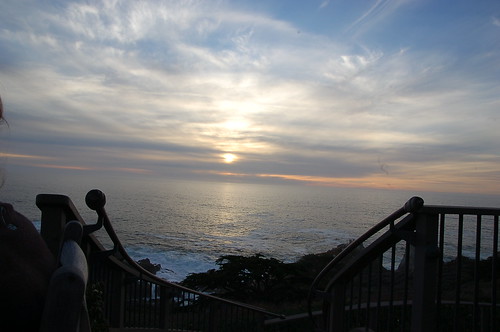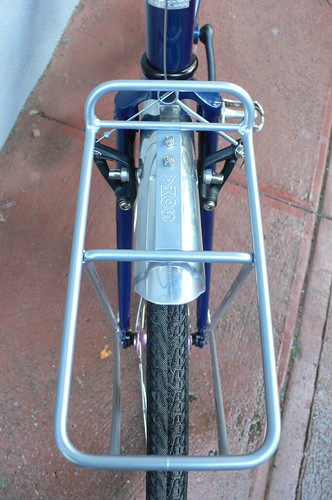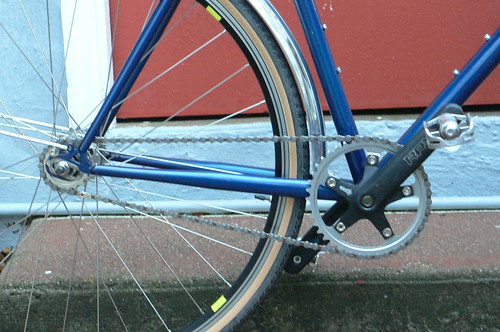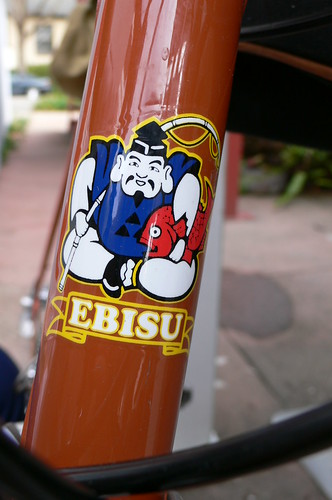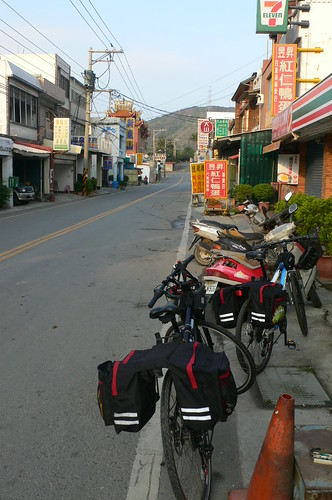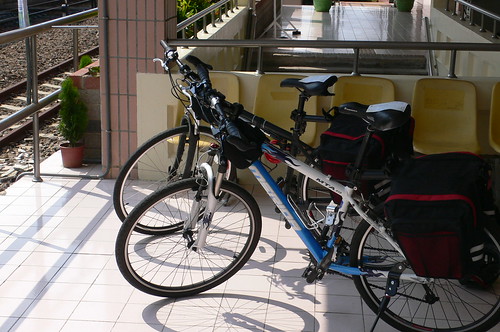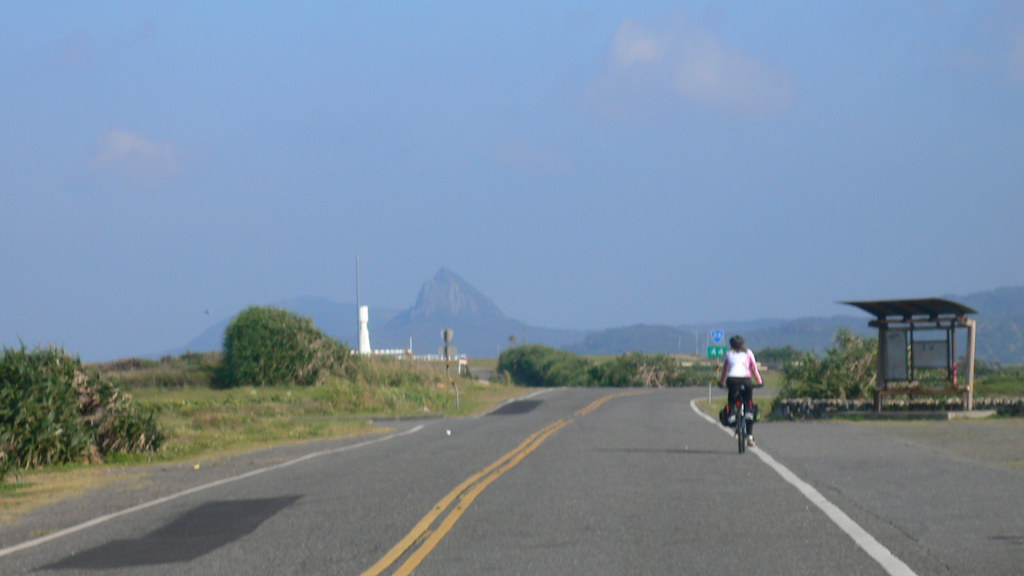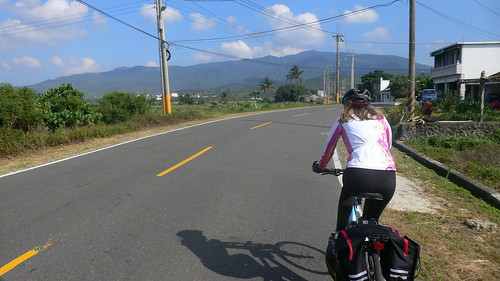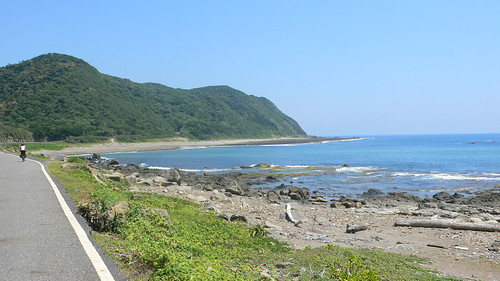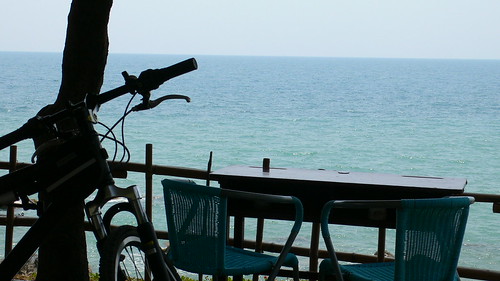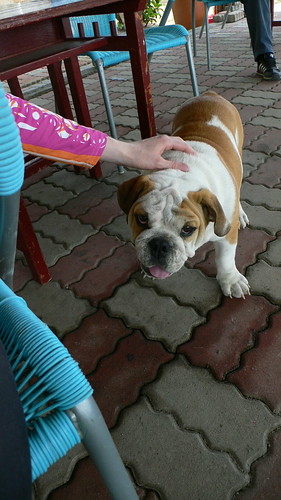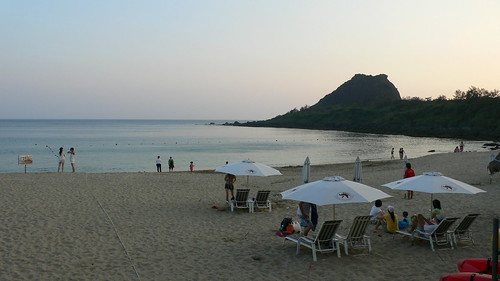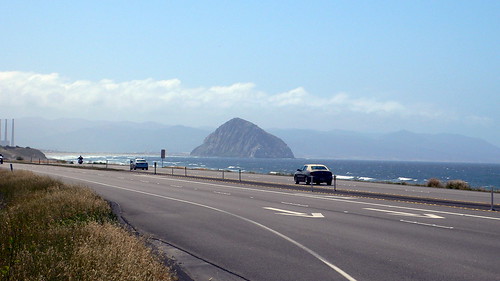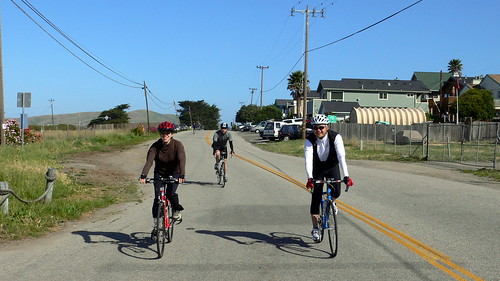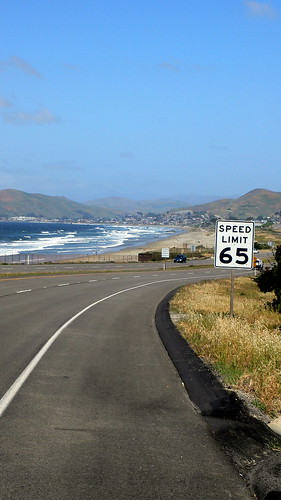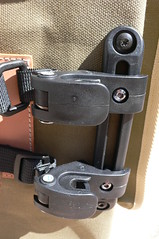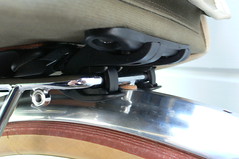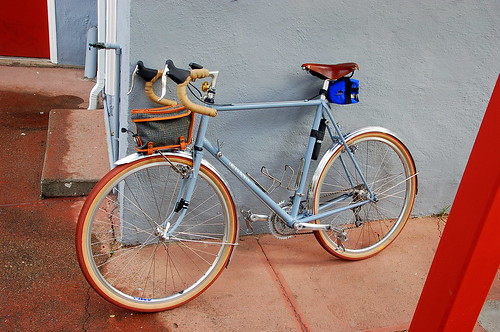The
small set (of 4) pictures I have on the event on my flickr
I saw a posting on one of the online lists/forums I am on about a fall 200k brevet that the San Francisco Randonneurs are organizing. I have wanted to participate in one of these timed and unsupported cycling event for a while. Since I am familiar with the route--having done something very close to it with my wife on our own--and the forecast was good, I sent it my form and a check to register for the event.
I have to convince M. that I would be OK. She didn't think I was in shape for riding 125 or so miles, and was afraid that I'd injury myself similar to the way she did on our ride in Shasta in August. I assured her that I had kept some semblance of cycling shape after my last long ride--2-day, 140-mile ride in late september--by riding from Menlo Park to Union City across the Dumbarton Bridge time-trial fashion three times a week. She was kind enough to not only let me do the ride, took me to the starting point on saturday morning, and agreed to come pick me up in case I decide to bail out.
The day before the event I checked out
my Ebisu to make sure everything works and began to pack. I decided to take two small bags--Rivendell lil' loafer front bag and Acorn small saddle bag--because the weather would be mild and I knew where I could get supplies if I had to. I heeded the advice on SFR's website to bring at least 1000 calories and packed 6 energy bars (3 Clif, 1 Lara, 1 Pro Bar, 1 trail-mix bar from Costco), 2 flasks of expresso-flavored hammer gel, and 2 2-serving packets of Hammer Perpetuem drink powder. I also packed some simple tools, a pump, a spare tube, electrolyte pills, reflective clothing, sunscreen lotion, and a DiNotte battery-powered headlight. I thought about using the SON dyno wheel and the B&M IQ Cyo combo I have sitting in my bike storage, but decided to keep the set up as light and as familiar as possible. Here are the contents of the bags before I started riding:
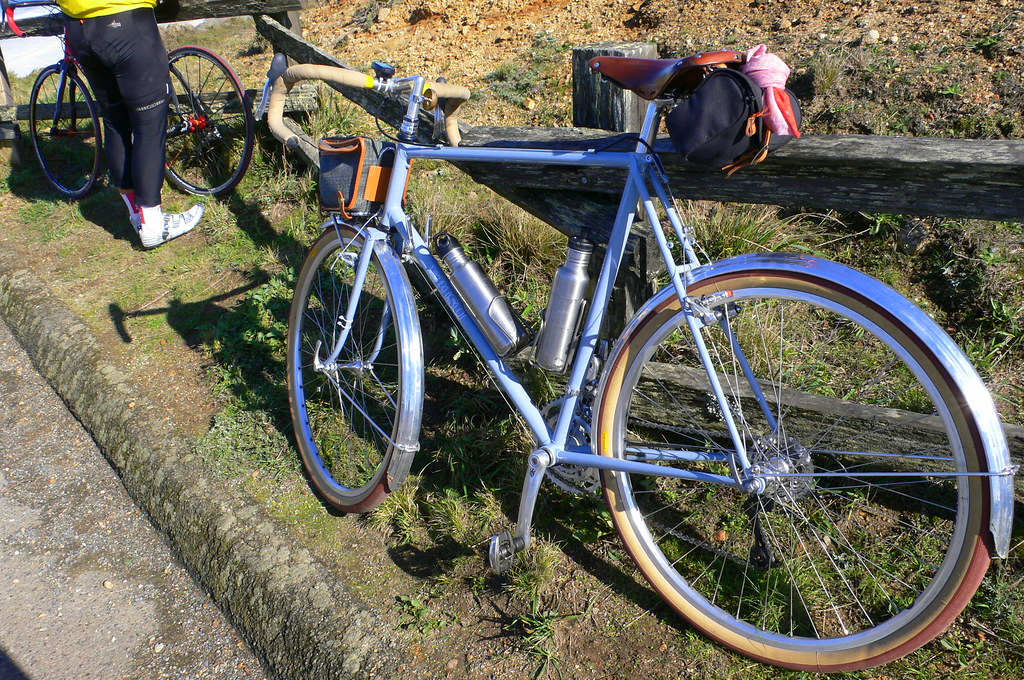
Front Riv Lil' Loafer:
- 4 energy bars
- 2 flasks of Hammer Gel, expresso flavor
- 20 Hammer electrolyte pills in an old Tylenol bottle
- 2 packs of 2-serving Hammer Perpetuem energy drink mix
- my panasonic lumix DMC-LX1 camera
- cue sheet
- Dinotte battery-powered headlight and battery pack
Rear Acorn small saddle bag
- 2 energy bars
- Quicker Pro mini pump
- tool pouch: park multi-tool, chain tool, spoke wrench, tire levers, patching kit
- spare tube
- Badger sunscreen lotion (the really white stuff)
- reflective vest and anklets
- rear blinker light
I went to bed early on friday night and got up at 5 to get ready. My breakfast consist of 1 and 1/2 cup of oatmeal. After filling up the water and changed into bike clothing I took out last night. I woke M. up and we got on the road. I got to the parking lot on Lincoln at about 6:45am. I grabbed the bike and quickly double checked that I have all the things I need and saw M. off. By the time I got to the Strauss statue, brevet coordinator Rob Hawks has already started the pre-ride talk. I checked in with a volunteer and picked up my brevet card. The volunteers have some small ziplock bags available; i grabbed one to keep brevet card and cash on my body without getting too wet from sweat.
I looked around and there seemed to be quite a bit of folks. I saw a few familiar faces from previous bike parts exchanges or online correspondences. At 7AM we were off. I followed a few riders down toward the underpass to get to the west sidewalk of the bridge. The weather was pretty calm at this point and it was beautiful riding across the bridge.
I felt comfortable in my clothing in the somewhat nippy morning temperature. I had a padded biking shorts on and a Riv MUSA knicker outside. For the top I had a merino wool based layer from BackCountry.com that I got on sale, and a yellow Livestrong T-shirt that I got as a gift. I wore a pair of wool socks that I got from Rivendell and a pair of Shimano mountain-biking/touring shoes so I can use the crank brother clipless pedals I have on the bike. Throughout the day, though the temperature noticeably--warm in Pt Reyes during mid-day, and pretty chilly, especially after sun down--I felt pretty comfortable in this outfit, and i never took anything off or put anything on, except for a neck-cozy that I bought in Taiwan in May, which is mainly used for sun protection.
I rode behind several riders who did not appear to be part of a group. Our line of 6-7 riders passed a few folks going at a leisurely pace all the way across the bridge, and down the hill to Sausalito. I stayed with them until the bike lanes began to show up in the Sausalito Lateral. Since I didn't meet up with anyone to do the ride, I decided to settle into a comfortable pace and enjoy the morning. I passed several riders and got passed a few times. We (the randonneurs loosely spaced) rode past the boat houses on the bike paths. I waited with about 10 others at the light at E. Blithedale to make the left turn. Shortly after, Camino Alto awaited and it was the first climb of any sort of the day. I dropped to 36/22T combination and spun comfortable up the gentle grade. Clayton Scott, whom I bought a pair of Grand Bois tires from a few weeks prior and whom I'd see a few more times today, passed me on the climb on his silver Quickbeam. Another rider on a large orange Rambouillet also passed me toward the "summit". I got by a couple of gentlemen, one of whom was riding a Steve Rex steel custom. Going down hill on the other side was fun. Rob Hawks stopped ahead of us to warn us that a big pickup truck was pulling out. The Ebisu with its 40mm Hetres made the not so steep but somewhat winding descent an exhilarating one.
I was pretty much by myself at the bottom of the hill, as the Rambouillet rider pulled away from me pretty quickly. I rode through residential streets of Larkspur, Ross, San Anselmo, and Fairfax. In Fairfax I got onto Sir Francis Drake Blvd (SFD) toward Whites Hill. I'd notice that my front fender was a little misaligned--probably got whacked out of alignment when I put the bike in my trunk in the morning--when i was climbing the last bit of Camino Alto. It wasn't serious enough to bother me so I decided not to stop before the climb to fix it. Whites Hill is definitely more difficult than Camino Alto--in fact harder than I remembered. I dropped down to 36/26T during the steeper pitches and pulled myself up to the top. Just before the top I pulled over where there is a pull-out and adjusted my fenders so things wouldn't get caught at high-speed on the descent and cause problem. Several brevet folks passed me at this point, while I was making the adjustment. I smiled and waved them off as they asked if I needed help.
The descent to Woodacre on SFD is fast and short, and I took full advantage of it and tried to leverage as much of it as possible on the flat. I came up to a rider on a Taylor--Bonnie is her name, I later learned--bike on the descent and we traded pulls for a while on SFD Blvd. I asked her if she knew how to get on the partially unpaved cross Marin trail that is a sanctioned alternate route to pot-holy SFD Blvd in Samuel P Taylor Park. We chatted a bit as she led me to the bike path and we rode together until Olema. The bike path was very beautiful, and definitely much more pleasant than SFD without the bad pavement and the cars--though not many cars were on the road this early in the morning. My fendered ebisu handled the unpaved path with ease, and dirt wasn't a problem at all. In fact, the time on the path was one of my favorite part of this ride, even though conceivably I could go a little faster on the main road. Bonnie had to meet up with someone in Olema so we parted ways after descending the hill before HWY1.
The only downside of riding with someone else was that I forgot to eat and drink regularly. After riding for 2 hours, I only ate 2 energy bars and possibly only 1 electrolyte pill. On the leg toward the lighthouse I began to feel more sluggish, and on the hill leaving Inverness toward the Pierce Road intersection on SFD I felt a very subtle sensation of cramping in my calves. I stopped and sucked in a full service and half of the Hammer Gel and swallowed another electrolyte pill before grinding my way up that first hill. I had to go at a reduce pace the rest of the way to the lighthouse to stave off the onset of full-out cramping in my legs. I frequently and regularly ingest liquid and food on this leg, but the body takes time to recharge, and I didn't feel recovered completely even as I got to the lighthouse parking lot. The stretch was extremely beautiful, though, and my less than perfect physical state actually was a blessing as I was able to enjoy the scenery and atmosphere more. The sky was pretty clear, but the wind--and the waves--was raging. Several cars with surf board on them drove past me and were evidently heading for the beach. I haven't been to this part of the park for a while, and forgotten how beautiful it is. Even though I wasn't at full strength, i really enjoyed the ride.
I pulled in the parking lot just around 11AM. I greeted the volunteers and other riders, and got my card signed and signed in. The vista was crazy beautiful at this location, as the landscape is open is almost all 4 directions and you get at least 210 degree of ocean view. Large birds were balancing themselves in the ferocious wind. I smapped a few photos, filled up my water bottle, and ate more food. Lee, one of the volunteers at the control came and chatted with me about my 650b hetre tires. He has a Rivendell Saluki and currently uses Riv Fatty Rumpkins. I told him that I have experience with both types of tires and recommend the hetres highly. I spent about 15 minutes at the control and headed off. As I rolled downhill, I saw 10-15 riders were still coming up.

The return leg toward HWY 1 was only slightly easier, as even though overall there is a decrease in elevation, and one got more tailwind than headwind, I haven't completely recovered from my calorie depletion and still suffered some on the few uphills along the stretch. I dragged and cheered, and lured myself on the prospect of lunch in Pt Reyes Station, and continue to suck on my gel flask. I reached the Pierce Road intersection and welcomed the extended downhill toward Inverness. The trip next to the bay/swamp was pretty fast, and I got into town quickly. At this point I am positively hungry as it was now past 12:30pm.
I pulled into the bike parking spots near the end of the strip. John Potis, who also has a Ebisu came and chatted with me about my Ebisu briefly. My hunger must be very apparent as he quickly urged me to get some food. I grabbed the water bottles and my wallet and walked into the famous Bovine Bakery. I bought 3 vegan veggie rolls, and filled up both of my bottle. I went and sat down near my bike and ate two of them really quickly. I bought the third one knowing that I won't be able to finish, but wanted to keep it just in case. I rested and spent quite a bit of time in town--probably an hour--to make sure the food got digested, as I didn't want to feel weak for the rest of the trip--I was at mile 74, and still had about 50 miles to ride, although the hardest part is behind me. I watched as other randonneurs rode past me, but decided to take it conservatively and rest a full hour.
I finally got up at about 1:40PM and began rolling again. The leg to Marshall is basically flat, with only 2-3 non-trivial rollers. I could feel my body regaining strength as I went. I saw many people on the way back as I rode. I got to Marshall fairly quickly, but missed the store and went past it for a mile (not sure how I did that). I turned around and got to the store. 10-15 randonneurs were there buying food and eating chowder. I saw Ron Lau, who sold me many parts and accessories that are on my Ebisu. He was riding his blue custom Bilenky rando bike. We chatted a bit while we were in line. The woman at the store stamped my card as I paid for my $1 bottle of water.
I used the porta-john outside the store, and mixed a packed of Hammer Perpetuem energy drink in one of my bottles. I got on the bike and felt pretty good--probably aided by the good tail wind. The return leg to Pt Reyes Station took me a little more than 20 minutes. As it was slightly past 3pm. I checked the amount of water, gel, and energy drink I had, and made myself ingest regularly. I rode past the reservoir, and got to Nicasio at a decent pace. I stopped next to the baseball diamond in Nicasio to lie down on the grandstand a bit and called M. to let her know I am ok and should be able to finish without much problem. I checked the time at this point--close to 4--and thought to myself that it'd be good to get as much of the hills behind me as possible. I got on the bike and rode toward the hill on Nicasio Valley road. I turned on my rear light but decided to put on the front light and reflective clothing later. The hill on Nicasio Valley was actually pretty easy. I powered up without much problem, and descended back to SFD. I put on my reflective vest, the front light, and the anklets before Whites Hills even though it was still bright then.
Whites Hill was also easier than I expected. The regular and sufficient calorie intake has paid off, and I felt pretty strong at this point. I rolled through the residential towns of Fairfax, San Anselmo, and Ross. I got to the base of Camino Alto at about 5:30PM, just as it began to get dark. I took my time going up as my battery front light was already crapping out--possibly because I didn't charge the batteries fully. I got to the top and began the descend. At this point the light was pretty dim and the descent turned out to be a bit more hairy than I wanted.
I stopped at the gas station on E. Blithedale to buy a pack of batteries. At this point I was staring at a 6:30pm finish at a easy pace. I called M. again and got some water on the bike path. I'd never ridden through this area at night, and find myself enjoying the relative quiet and less busy streets. Sausalito was still buzzing in the early evenings. Tourists on rented bikes--without lights--were still coming downhill, precariously. I began the final climb of the day. I took my time, and enjoyed the lit skyline of San Francisco with the bay in the foreground as I rode. I had to cross to the east sidewalk as it was totally dark now. With many tourists still on the bridge, and most of them without any illumination, I had to proceed carefully. I pushed--you have to hold it for a short while--the button for the gate leading to the gift shop area a few times before it opened. I rolled into the parking lot and stopped in front of the volunteer table. Jim G., whom I have corresponded a few times on various bike related topics was there checking riders in. We had a brief exchange, as I was getting cold and still needed to get to BART to go home. I turned in my brevet card and signed in. I stopped to call M., and headed toward BART. I got back to Berkeley before 7:30PM, and actually felt pretty good.
I really enjoyed this brevet, my first one. The fall weather condition and temperature is much easier on my easily-heated body. I made the mistake of irregular and insufficient calorie intake in the morning, but recovered after eating lunch and imposing on myself a more regular regiment. Though the morning's lack of discipline weakened me and required me to take a much longer than otherwise necessary lunch break. I feel I can probably improve my time noticeably if I stick to eating and drinking throughout the ride. This was actually the most mileage on one ride I did this season--though my incomplete Shasta Super Century (120 miles and 12000 ft of climbing) and Big Basin training ride (80 miles and 11000 ft of climbing) in the summer were harder--even with what was perceived (by both M. and I) to be completely lack of training immediately before it. My attire was adequate for the weather, though after dark I felt a little cold. I would probably bring another layer for the january ride which goes on the same route.
The Ebisu performed flawlessly. I had no mechanical problem. I actually felt little strain that I sometime experienced on long rides in my neck, shoulder, and wrists. My hand got numb for short stretches toward the end, but minor adjustments to the handlebar and stem could take care of that. I never felt really uncomfortable on the bike the entire ride. The ride quality was great, as the hetre provided a cushy but still fast ride. I rode no-handed to eat or drink a few times and felt fairly confident doing so. I would probably go with a slightly bigger bag next time, either to have the large Inurijushi front bag and no rear bag, or a slightly bigger rear bag--the mid-large acorn bag--to go with the lil' loafer. Overall, it was a great day of riding, and a perfect initiation into the sport of randonneuring.

